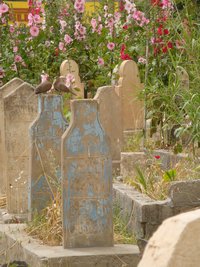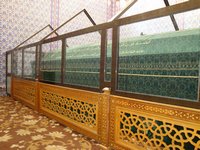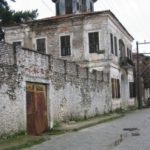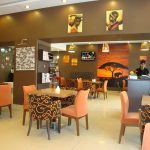Writing about Cizre this week memories from last year came flooding back. Cizre was one of the few towns in Turkey I had never got round to visiting. It sits, you see, in a triangle (Cizre-Siirt-Şırnak) that people are always keen to warn against visiting. In any case information about Cizre was quite hard to come by, the guidebooks tending to give it a suitably wide berth. But my curiosity had been piqued by seeing the lovely wooden doors taken from its 12th-century Ulu Cami in the Museum of Turkish and Islamic Arts in İstanbul, and so it was only ever going to be time until eventually I found my way there regardless. The chance came last summer when a few days in Midyat slowly spun out into a very enjoyable week in which that town became my base for exploring the area.
Cizre was only a short bus ride away with a quick change in İdil. The problem was to know where to start once I got there. The bus dropped me off on a scrap of wasteland that was clearly not the town centre. Locals pointed me towards the dolmuş into town. “I want the Ulu Cami,” I said to the driver who looked at me as if I’d asked to be taken to the moon. Minutes later with a beaming smile he urged me to leave the bus in front of a mosque that could only have been built a maximum of ten years ago. With a sigh I set off to walk the rest of the way, pausing periodically to enquire of a series of bemused locals where their venerable mosque might be found.
The outskirts of Cizre were not inspirational. This was a town, like so many in Turkey, that had grown at breakneck speed and with only the barest semblance of planning. A heartsink city, I was inclined to label it, so already I was not in the best of frames of mind when I came upon a pop-up pet shop on the pavement. There to my horror I saw a green monkey for sale, not to mention a poor squirrel that had all but gnawed away its own tail. In a box a huge rabbit lay panting in the sun. “It needs water,” I said sharply with little hope that anyone would do anything about it.
But just as I was thinking that things couldn’t get much worse I came across a shop whose owner’s ears actually pricked up at mention of the Ulu Cami. Shortly afterwards I was walking past the fine stone mansion that housed the town’s museum (sadly closed since I’d chosen to visit on a Monday) and then down towards the mosque. As soon as I spotted it I laughed at the very thought that anyone could have confused it with the new mosque. Cizre’s Ulu Cami lurks behind an enclosing wall but its originality is immediately obvious from the minaret rising above it. This starts on a square base and then graduates to a column before ending up in what looks like a spike. There’s nothing like it anywhere else in Turkey.
Somehow when you find your way to somewhere off the beaten track you always assume that its historical monuments will be readily accessible. In reality, though, they’re probably even more likely to be kept locked up for lack of visitors, and so it was in Cizre where I hung about hopefully and questioned everyone who passed by without managing to find out when the imam would come and unlock the doors. Disappointed, I wandered up the road and stumbled upon the lovely local cemetery, a rambling wild-garden of a place full of flowering hollyhocks in reds and purples that towered over the ramshackle graves. Such a pretty place had inevitably attracted its quota of picnickers for whom the arrival of a stray yabancı was a source of great amazement. Within minutes someone was rushing over with a glass of çay in their hand.
“Where are you from?” they asked and when I replied that I was from England but lived in Nevşehir the look on their face became as stupefied as the bus driver’s. Lovers of this question only ever hear the England bit of the reply, you see, never the Nevşehir bit that might make me seem a little less exotic.
The cemetery was ringed with a crumbling old wall and as I followed it round I came eventually to the low-lying Abdaliye Medresesi, built in 1437 and restored in 2007 with the help of European Union funding as part of the GAP (Southeast Anatolia) Project. It was the sort of restoration about which I harbour deep reservations since already weeds were pushing up through the new paths for lack of maintenance. Personally, I would probably have found the old ruin more romantic, but beneath the mosque I discovered the tomb of Mem and Zin and with it the story of Turkey’s own Romeo and Juliet, a couple as divided by tribe as the Capulets and Montagus, and with the same tragic consequences: the death of one followed by the demise from grief of the other. Their story was recorded by Ahmed-i Hani (1651-1707), the great Kurdish poet whose tomb can be seen near the İşhak Paşa Saray at Doğubayazıt.
Leaving the medrese, I followed the wall all the way round, smiling at the unexpected juxtapositioning of tropical palm trees with the oh-so-English hollyhocks. Eventually though my footsteps dragged me back to the Ulu Cami. Surely at some point the imam would appear to open it, I hoped, but no, even on this second try the gates were just as securely locked and there was nothing to do but admire the ancient gravestones embedded in the walls and then leave again.
This time I took the side gate out and as I was wandering along the road a young man appeared and attached himself to me. Let’s call him Ahmet. He must have been about twenty, bored, with no work and not much prospect of it either despite mutterings about waiting in restaurants near Alanya. We exchanged scene-setting pleasantries and I explained about wanting to see inside the Ulu Cami, but he was too young and probably too secular to know where the key might be found. He was, however, very keen to show me what he regarded as the real gem of his home town which was the tomb of the Prophet Nuh (Noah), a short walk away through the back streets. From my point of view this shrine was more of a curiosity than a beauty. Noah was entombed in a ludicrously elongated tomb surrounded by a wooden fence but inside a modern space adorned with cheap-looking blue tiles that clashed with the green drape over the sarcophagus. The shrine was plonked down in the middle of a naked square with only a modern mosque to keep it company (apparently there was once a church on the site), and this being the far east of Turkey in mentality as well as geography men and women were expected to enter the shrine using separate entrances.
Leaving, I half-expected Ahmet to have grown bored and continued on his way. He was, after all, less than half my age and surely had to have realised that I was not going to be paying for his services as a guide, nor yet picking him up as a toy boy. But when I re-emerged he was still there waiting for me and I resigned myself only slightly peevishly to having company for the rest of my stay.
Perhaps that was no such bad thing after all as without Ahmet I would probably have called it a day with Noah and headed straight back to Midyat. With him, though, I found myself heading rapidly for the semi-fortified Kırmızı Medrese (Red Medrese), another building to have received an EU-funded makeover and this time a much more impressive structure, its courtyard surrounded by very Persian-looking eyvans with shallow arches, the mosque at the heart of it enthusiastically open to visitors unlike the Ulu Cami. Beneath the mosque we entered the tomb of Ahmed-i Cezeri (1570-1640), a local poet who had been buried in a shrine with a strangely concave dome that rendered standing up straight difficult. It was here that I started to feel awkward about Ahmet. It was one of those situations with which all lone female travellers will be familiar, when you suspect that a man is angling to get a little closer to you than you would like although without doing anything incontrovertibly offensive. Were you to make a fuss, then, you would risk making a fool of yourself when the man protested his innocence. And so you say nothing.
That was it for me though. I’d enjoyed myself. I’d found more to appreciate in Cizre than I’d expected. The trip had more than justified itself but now an element of doubt was muddying the water and all I could think about were the wealthy women in their fifties whom Ahmet would have seen with their much younger and poorer boyfriends in the coastal resorts. I let him guide me back to the wasteland parking lot. There I bought him a Fanta in a cafe overlooking a wall graffitied with the words PKK and Apo. Perhaps I was doing my young companion an injustice but as I settled into my seat for the return to İdil I could only think that the day had come to an end at just the right moment before anything could happen to sour it.
Written: 15 January 2012





